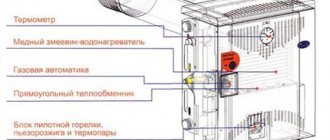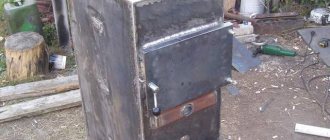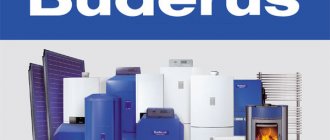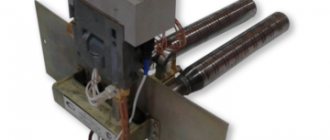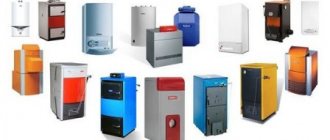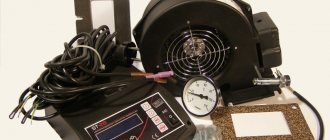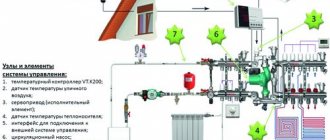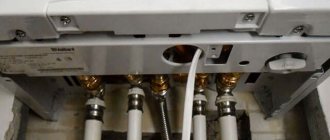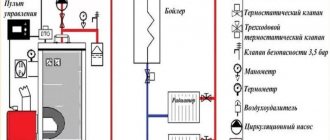You have built a residential building and want to move in as quickly as possible and finish the interior arrangement. The question arises: how to heat water and heat rooms if the home is not gasified? The simplest way to quickly organize heating and hot water supply is to install a double-circuit boiler that runs on liquefied gas (abbreviated as LPG).
The heating unit must be reconfigured to a propane-butane mixture, and after connecting the main line, the factory settings must be returned. We will reveal the features of installation, adjustment and operation of a heat source using bottled gas.
Which automation is better - mechanical or electronic?
Devices that control the operation of heating equipment can be mechanical or electronic. In budget models of gas boilers, in most cases, a mechanical, manual control option is used. Despite the fact that the level of technical progress has reached unprecedented heights, mechanics remains a reliable and proven tool. Automated safety systems for gas boilers, operating in manual control mode, are an order of magnitude cheaper. The operating principle of most models of manually controlled boilers is simple and understandable for domestic use.
The automation unit of the mechanical operating principle is easier to maintain and repair. Disassembling such a unit is quite within the capabilities of a specialist - a heating engineer who carries out a preventive inspection of the boiler equipment in your home.
Manual, mechanical control of a gas boiler is independent of the power supply - the home owner independently sets the temperature required for heating the living space, everything else depends on the laws of physics that form the basis of the mechanism’s operation.
Mechanical automation
Manual adjustment of household gas boilers is ensured by the entered settings of a given range of optimal temperature values. Ignition of the combustion chamber flame wick starts the thermostat, which is sensitive to changes in the coolant environment.
Gas boiler burner
The temperature regulator pumps the gas supply to the burner when the water cools in the heating system circuit, and shuts off the flow when it is sufficiently heated. A temperature sensor is installed in the gas pipeline. It is equipped with the following components:
- thermocouple;
- group of levers;
- spring pipe;
- core.
The core is a brass tube and an Invar rod, a sensitive element that responds to changes in the state of the coolant. By changing the length, it opens and closes the valve, adjusting the supply of energy to the combustion chamber of the device.
Electronic automatic control systems
The most common type of automation used in budget boiler models is an electronic thermostat.
The device is installed indoors and controls heating based on signals from an external temperature sensor located in the current zone of the room. When the temperature drops below the set limit, a signal is sent to the boiler to turn on. When optimal temperature parameters are reached, the sensors transmit a shutdown signal to the system. Room thermostats have a cable connection with gas boilers.
In this case, the presence of a thermostat ensures the optimal heating temperature of the gas boiler and economical consumption of blue fuel. Today, there are several types of thermostats on sale, differing in functionality, technical characteristics and installation method. Programmable devices ensure that the optimal temperature regime is maintained inside the living space for a given period of time.
Note: some models can automatically control the operation of a gas boiler during the day, while other models of equipment can control the operating unit during the week. Wireless automatic control devices are also produced that allow remote monitoring of the boiler operation. The range of modern remote control systems, depending on the chosen model, is 25-100 m.
Electronics or mechanics
Modern boiler units, especially Western ones, are equipped with electronic boiler control systems, the cost of which reaches up to 30% of the total installation cost. The advantages of such a system are obvious; there is one drawback: it is afraid of unstable operation of Russian electrical networks. Therefore, it must be operated with reliable stabilizers and autonomous power supplies.
The range of regulation and control of the electronic system is practically unlimited: from pressure and temperature of the coolant to weather-dependent control of the heating unit.
In the safety system, the boiler will be turned off from the fuel supply at high/low gas pressure, torch separation, lack of vacuum in the furnace, low/high pressure and coolant temperature.
Mechanical actuators are also installed - a gas shut-off valve that is triggered by unacceptable gas pressure and a safety relief valve that protects the internal circuit of the boiler from high environmental pressure.
For example, the Buderus boiler unit is started by squeezing the gas valve washer, at the same time it opens and gas is supplied to the igniter. It heats up a thermocouple, which produces a current with enough voltage to drive an electromagnet to hold the valve open.
Next, the power of the boiler unit is set by the regulator, which allows gas to flow in the required volume with the operating pressure, and the heating process is controlled by a thermostat.
How to calculate the volume and number of cylinders for a boiler
As practice shows, for a house of 100 m², gas consumption will be approximately 2 cylinders per week. Accordingly, for a house of 200 m², consumption will increase to 4 units. A gas heating boiler consumes 9 (100 m²) -18 (200 m²) propane cylinders per month, depending on the total heated area. The calculation of the required number of containers is carried out taking into account this coefficient.
Thus, installing a gas boiler room in a house using propane cylinders for 100 m² will require simultaneously connecting at least 4 cylinders (2 working and 2 reserve), for 200 m² 8-10. To ensure maximum ease of use, the connection equipment set must include a ramp.
You can accurately calculate the need for a boiler running on bottled gas using the technical documentation provided by the manufacturer. At least, European concerns indicate in the equipment instructions the consumption of LPG after the unit has been re-equipped.
Gas cylinders must be refilled with propane after the container is 90% empty. Gas production is completely prohibited.
Refueling
Cylinders undergo mandatory certification once every 3 years - this is necessary for the user’s own safety. Such containers can serve for about 10 years. A standard home consumes about 10-12 cylinders per month, so they will have to be refilled weekly - you cannot transport more than 3 cylinders at a time without special permission.
Before filling, the vessels need to be prepared. To do this, you need to remove condensation, which artificially reduces the useful volume and harms the steel walls. Removing condensate is the prerogative of specialists; doing such work yourself is always a risk. If for some reason it is difficult to find a specialist, you will have to carry out the procedure yourself. The cylinder is taken out to an open space without sources of fire, grounded and then the reducer is removed. Leave for 2 hours to allow any remaining gas to evaporate. After two hours of inactivity, the vessel turns over and the water flows into the ground. You can take it to a gas station.
It is worth choosing a gas station that organizes both transportation and a guarantee for the work. It is better not to contact car stations, because their equipment does not have a special cut-off valve that regulates the filling of household gas cylinders. They also do not have a special connector for connecting the cylinder to station equipment.
If it is not possible to connect to the central gas pipeline, then some owners of private houses decide to install autonomous gasification. The heart of such a system becomes a gas boiler running on liquefied gas - the unit is connected to a gas holder or propane cylinders.
How to convert a heating boiler to liquefied gas
The main difference between natural gas and liquefied gas is that the former is supplied and burned at a higher pressure. The automation of conventional equipment is configured for indicators equal to 6-12 atm. When the readings drop, the pressure sensor is triggered, turning off the burner.
Operating a heating boiler using a propane-butane mixture requires changing the configuration and parameters:
- It is necessary to change the supply speed of the gas-air mixture.
- You will need to install a set of liquefied gas jets.
- Configure automation for other operating parameters.
Modern single-circuit and double-circuit heating boilers are designed to operate on liquefied and main gas. Conversion requires replacing the nozzles and switching the boiler to another mode.
The technical conditions for the use of liquefied gas in individual boilers not intended for this type of fuel differ significantly. In addition to replacing the jets, complex reconfiguration of the automation and control valves will be required.
It is difficult to correctly regulate the gas supply to the boiler when switching to liquefied gas, set the minimum pressure limit and perform other work independently, without special skills. According to current regulations, all work must be performed exclusively by licensed specialists.
The technical documentation of heating equipment indicates the minimum pressure at which the burner continues to operate. The lower this indicator, the more propane-butane mixture it will be possible to use from a filled fuel tank. Typically, 15-30% of the total volume remains in the container.
Nozzles for boilers for liquefied gas
In the section on how to convert a heating boiler to the flow rate of a gas boiler running on liquefied gas, the need to replace nozzles or nozzles was mentioned. Re-equipment is required for several reasons:
- The difference between nozzles for liquefied and main gas is the different diameters of the outlet. As a rule, jets for a propane-butane mixture are narrower.
- After installing a set of nozzles to convert the heating boiler from natural gas to liquefied gas, the pressure in the system increases slightly.
- The reduced diameter of the nozzle leads to a decrease in the flow rate of the gas-air propane-butane mixture. For normal operation of a 10 kW unit, the pressure is required to be no more than 0.86 kg/hour.
Injectors or jets are sold in sets. Some manufacturers include in the basic package all the fittings necessary for conversion. In other cases, the kit will have to be purchased separately.
What is the liquefied gas consumption of the boiler?
The volume of liquefied gas consumption in gas heating boilers is indicated in the technical documentation provided by the manufacturer. It is different for all models and depends on several factors:
- Performance.
- Burner type.
- Equipment setup.
The technical characteristics of liquefied gas consumption are also affected by how suitable the selected model is for a given type of fuel. On average, for a 10-15 kW unit, you will need 2 cylinders per week and per month.
Which gas is more profitable to heat - natural or liquefied?
Comparative consumption of natural and liquefied gas when operating a heating boiler shows that it is more profitable to heat a house when boiler equipment is connected to the main line. Heating with a propane-butane mixture should only be used in the following cases:
- Changes in the design and reconfiguration of the boiler when using liquefied gas are temporary. From the start of registration and ordering of a project for the installation of heating equipment connected to the main gas pipeline, it may take about six months. During this period, it is not economically feasible to heat the premises with electric or solid fuel heating equipment specially purchased for this purpose. The cost of converting a conventional boiler to liquefied gas ranges from 500-1000 rubles.
- Connecting a gas holder - in this case, the cost of using the mixture is more profitable than heating with wood, electricity or diesel fuel. The only condition is that a qualified specialist must adjust the pressure of liquefied gas and regulate the operation of the automation. Incorrect settings lead to an increase in consumption by approximately 15%.
The economic component, operational safety, the possibility of switching back to natural gas - all these factors make it advisable to use boilers running on liquefied gas.
Peculiarities
A propane boiler operates on almost the same principle as when gas is supplied from the mains. The difference is that the supply comes from cylinders that need periodic refilling. This type of heating is used, as a rule, in small areas, or if the room does not need to be heated on an ongoing basis.
These devices do not have any significant design features; however, they have a nozzle installed that is designed to work with high pressure. In order to install and connect the device, we recommend contacting a specialist. Although this process is not very complicated and if you follow safety rules, you can do it yourself.
Heating boilers running on liquefied propane gas are installed according to the same scheme as when connected to the gas main. One of the disadvantages of this equipment is the need for frequent refueling. But even in this situation, there is a way out; you can connect up to 10 cylinders to the individual gas supply system.
This is done using a ramp; it makes it possible to recharge from 10 cylinders at the same time. It has the appearance of a two-arm separating collector. Initially, propane gas is used from the main cylinder, then, when it runs out of propane, it automatically switches to the reserve tank.
In order for the device to be supplied with optimal operating pressure, be sure to install a gas reducer; it will allow the heating system to operate without interruption.
How to connect a gas boiler to a propane tank
Installing a gas boiler for autonomous heating using bottled gas is much easier than using mains fuel. There are several rules regarding fire safety, equipment reconfiguration and power calculations that require strict compliance.
Unauthorized installation is not recommended. It's better to invite a specialist. Provided that the boiler is properly connected and re-equipped, installation work will take only a few hours.
Is it possible to install gas cylinders in the boiler room?
The norms and rules for installing a cylinder are regulated by industrial safety requirements. In particular, it states that containers with liquefied gas cannot be located in the same room as heating appliances.
- Cylinders should be taken to an adjacent room or outside, installed in a special cabinet.
Empty gas cylinders should be stored outside the building. It is optimal if the containers are refilled immediately.
If cylinders installed in a cabinet outside freeze, the storage walls should be insulated using non-combustible thermal insulation. Heating containers or cabinets with open fire is strictly prohibited.
The gas cylinder can be installed at a distance of at least 2 m from the heating boiler.
It is prohibited to store compressed gas cylinders near the boiler room. Containers can only be stored in a specially equipped room located no closer than 10 meters, equipped with ventilation and without pits or a basement. This requirement is due to the fact that propane is heavier than air and, when leaking, accumulates at floor level. If there are pits or a basement, the gas concentration will become critical, which is enough to cause an explosion.
Operation of cylinders - complete exhaustion of LPG from the container is not allowed. Every 4 years it is required to carry out certification of the tightness of cylinders and the integrity of their walls.
Do I need to reconfigure the boiler for propane?
A conventional gas cylinder boiler only works if certain conditions are met and conversion is carried out. There is no need to reconfigure the equipment, but you will need to install additional fittings to stabilize the gas pressure.
Not every boiler is able to run on LPG
You should pay attention to the technical documentation. An essential requirement is the ability of the unit to operate at a reduced gas pressure of 3-4 mBar
What is required to switch the boiler to gas from a cylinder
For normal operation of the LPG boiler, several important conditions will need to be met:
- Replacing nozzles or burners. Gas-cylinder water heating equipment designed to operate exclusively on LPG is not produced. Some manufacturers make universal units equipped with an electronic processor. To switch from mains gas to cylinders, you simply need to change the cartridge. But more often, conversion will require replacing the nozzles or the entire burner.
Gearbox installation. Liquefied gas is pumped into cylinders under pressure, resulting in a transformation from a gaseous to a liquid state. To transform it back, you will need to lower the pressure. The gearbox is designed for this purpose.
Gas valve - in some models, connection and operation of a domestic gas boiler using bottled gas is possible only by replacing this unit.
A conventional gas reducer is not suitable for conversion. A gas heating boiler can operate from conventional bottled gas only when a unit is installed with a flow rate of 1.8-2 m³/hour.
Installation equipment
To install the heating system you will need:
- a gas boiler;
- burner for liquefied (cylinder) gas and the gas cylinders themselves;
- shut-off valves and gearboxes.
Burners for bottled gas differ in their configuration from conventional ones, and are usually included in the standard configuration of gas boilers. If necessary, they can be purchased separately. Shut-off valves and the necessary gearboxes can be purchased from the company or directly at cylinder refilling stations.
Connection
A cylinder or group of cylinders is connected to the boiler through a reducer with a throughput capacity of about 2 m3 / hour. Gearboxes for home stoves are designed for lower throughput - they are not suitable for a heating system. The gas tank system may have one common reducer or a separate regulator for each cylinder. The second option is more expensive, but this is what the experts recommend - separate gearboxes provide maximum safety.
Liquefied gas cylinders cannot be installed outdoors: the cold will cause a decrease in pressure, and the heating pad may refuse to work. The ideal installation location is a warm, ventilated area. It is important to remember that bottled gas is heavier than air, and if it leaks, it will pool at the bottom, increasing the likelihood of an explosion. Therefore, the room should be chosen separately from the living rooms. There should be no basements or subfloors in it!
Gas cylinders are connected to the boiler burner using a metal corrugated pipe - this reduces the likelihood of gas leaks due to system vibrations.
Flow adjustment
With the help of automatic sensors and correct settings, you can reduce propane consumption rates by 3-4 times. If we are talking about a country house, then the gas consumption will be even less: during the period of absence of people, the automation will maintain the temperature at 6-9 ° C, which will reduce the propane consumption to 0.7-0.8 cylinders per week. Heating a building with liquefied gas is not the cheapest option, but in some cases it is the most optimal if there is no problem with the delivery of cylinders.
The gas boiler performs its functions perfectly even when connected to the main gas pipeline. In this case, it is quite easy to switch the equipment to a constant source of fuel supply - just change the burner.
But if there are no prospects for connecting the building to the gas pipeline, you should once again calculate the feasibility of installing a gas boiler. For a house with a total area of more than 100 m2 and maintaining a temperature of about 25 ° C, it is worth considering the possibility of installing a solid fuel boiler or another heat generator and water heating.
Types of products by location
Equipment operating on liquefied fuel can be floor-mounted or mounted. Each option has specific characteristics that make it attractive and practical under certain conditions.
Having this information in hand, owners can independently determine which device is most suitable for them, and then purchase it in a specialized store.
Option #1: floor equipment
Floor-standing devices are the most widespread. These are high-power units that can provide comfortable heat and hot water not only to standard residential buildings, but also to large-sized country cottages.
The main operating element of the devices is a pressurized gas burner. It has a good degree of efficiency and has high heat dissipation.
Floor-standing devices exhibit stable operation even with a strong drop in gas pressure in the system and reliably serve in intensive use for 15 to 25 years, depending on the manufacturer
The boilers are equipped with a cast iron or steel heat exchanger. The cast iron element is heavy and has a long service life. A steel object is much lighter, but exhibits fragility, sensitivity to mechanical damage and shock, and lasts for a shorter period of time.
In addition to basic elements, progressive modules contain all kinds of auxiliary equipment that increase operational safety. These are sensors for monitoring the draft level, coolant volume and presence of flame, as well as thermostats that block operation in the event of an abnormally high level of heating of the working fluid
Depending on the manufacturer, the device is equipped with a piezo or electronic ignition system. In the first option, the device is started manually by pressing a button.
In the second case, activation occurs automatically, and the boiler does not consume excess fuel during operation, since the system does not have a pilot light with a flame burning continuously.
Detailed information on the selection and installation of floor-standing gas boilers is presented in the articles:
- Floor-standing gas heating boilers: types, how to choose, review of the best brands
- Do-it-yourself installation of a floor-standing gas boiler according to technical installation standards
Option #2: wall mounted devices
Boilers designed for wall mounting are compact in size and have a modern appearance. They take up a minimum amount of space and are suitable for placement in small rooms with complex layouts.
The installation of a mounted boiler is always carried out by a specialist who has experience in such work. The equipment must be installed in accordance with the safety requirements for domestic gas systems
Functionally, wall-hung gas units are no different from floor-mounted ones, however, they have slightly less power and are not very suitable for use in large, spacious houses. But they use fuel economically, while providing a high level of comfort in the living space.
Criterias of choice
To correctly select a boiler for SG, you need to take into account the parameters of the heated object - the volume or heating area, the degree of insulation of the walls, the size of the glazing, the condition of the attic floor and, of course, the climatic region of residence.
For the central regions of Russia, you can use an approximate calculation to determine the thermal power of the boiler unit: 10 kW per 100 m2 of heated area of the house.
When choosing a boiler according to technical characteristics, you need to pay attention that the size of the thermal power of the boiler unit must be indicated specifically for operation on SG
Convection or condensation
The efficiency of such a boiler unit largely depends on the method of using the heat of combustion of the fuel. Based on this parameter, a distinction is made between convection-type units and condensing boilers.
Conventional and condensing boiler
In the first, the heating of the coolant occurs due to the energy acquired from the direct combustion of SG, while some of the heat is lost in the atmosphere along with the exhaust gases.
In the second, the boiler design allows for more complete use of the received heat for heating the heating circuit and hot water supply, by reducing the temperature of the flue gases to the “dew point” of 55 C. In this case, condensation forms in the flue gases, releasing an additional condensation temperature.
Today, the use of such boilers is an innovative direction in domestic heat and power engineering, since they are capable of providing installation efficiency in the region of 105 -110%.
According to EU energy efficiency requirements, in many countries only condensing types of gas boilers are allowed for operation.
Wall-mounted or floor-mounted
The basic difference between wall-mounted and floor-mounted structures of gas equipment exists not only in the placement option, but also in the operating requirements:
- Mounted units - must be compact and lightweight in order to be safely mounted on load-bearing walls. Internal boiler equipment is also made of lighter materials, for example, the heat exchanger for the heating circuit is made of steel or copper, the heat exchanger for hot water supply is remote, in addition, this type of equipment has a more functional automatic control and protection unit.
- Floor-standing units are not limited in weight and dimensions; for this reason, they have not only a cast-iron heat exchanger for the heating circuit, but also an internal heater for DHW. They have good thermal power from 10 to 60 kW, capable of heating a house up to 500 m2.
Single-circuit or double-circuit
The number of boiler circuits affects the heating capabilities of the heating system. Single-circuit, provide only the heating load. Double-circuit, respectively, heating and hot water supply.
The efficiency of the installation is increased by reducing the temperature of the exhaust gas, which, before being released into the atmosphere, passes through the boiler to heat the hot water supply.
As a result, such an installation is more expensive than a double-circuit boiler, but more efficient due to the low specific costs of generating a unit of thermal energy. The payback period for such an additional device does not exceed three years.
Efficiency
The efficiency of a boiler or its efficiency is an indicator that determines how well the boiler equipment uses liquefied fuel.
For this modification of units, this indicator is especially significant, since it determines how often the owner will have to deliver fuel. For users of gas tanks, this is not so significant, although it also affects the cost of thermal energy.
Condensing boilers can provide an efficiency of more than 100%, boilers with an indirect heating boiler up to 95%, other boiler options are below 90%. For this category of fuel, devices with efficiency below 88% are not installed in homes.
How to determine power
To accurately determine the power, you will need to take into account a special coefficient. For the central regions of the Russian Federation, it is set on average for objects with typical ceilings up to 3 m: 10 kW per 100 m2 of heated area of the house.
Experts recommend applying to this calculation a climate correction factor for the northern regions, as well as 15-20% to take into account the following additional parameters:
- degree of insulation of the house;
- glazing area;
- attic option.
So, for example, for a residential building of 100 m2, the thermal power of an SG boiler will be:
- northern regions: 10x1.4x1x1.2 = 16.8 kW;
- central areas: 10x 1.2 = 12 kW;
- southern regions: 10x 0.8x 1.2 = 9.6 kW.
Which automation is better?
Today, the boiler equipment market is oversaturated with proposals for boiler automation coming from both imported and domestic manufacturers.
The first ones are very expensive and capricious, they do not tolerate the operating conditions of Russian engineering networks, the second ones are less functional. The best automation for a boiler is always its own, that is, produced in a single configuration by the manufacturer.
It is there at the stands that it receives the correct settings with the operating modes of the unit. An equally important factor in boiler room automation is the manufacturer’s warranty, which must guarantee its operation free of charge for at least a year and replace the unit if it fails.
German
German automation for boilers Vaillant, Honeywell, AEG, Bosch is quite popular on the Russian market, which is explained by its excellent consumer quality, durability and reliability. High level of automation and protection. Recently, German manufacturers have established automation of condensing boilers, ensuring efficiency. almost 100%.
Italian automatics
EuroSIT 630 is considered the best Italian automatic system for gas boilers in the world. It is produced in full compliance with EU standards, but at the same time has a lower price than German systems.
The EuroSIT 630 boiler automation covers all parameters of the boiler operation, but is very sensitive to the operating parameters of the gas line and electrical network. For this system, it is mandatory to install input voltage stabilizers.
Russian
Recently, more and more boilers are being purchased with Russian automation systems, since they provide a good protection system and reliable boiler control at the lowest prices.
The experience gained with automation of processes in industrial boiler houses has been successfully integrated into the operation of household boilers using the latest technologies and developments from European manufacturers. Among the large number of Russian companies, especially the most popular are Neva-Transit and Lemax.
Rating of popular models and manufacturers
Siberia boiler , manufactured at the domestic enterprise JSC Rostovgazoapparat, is the best-selling module among all those presented on the gas equipment market today.
It is a non-volatile unit with a highly reliable Eurosit automation system, made in Italy and fully adapted to domestic operating conditions.
The heat exchange tank is boiled automatically and due to this it has increased strength. Double-circuit boilers are equipped with a flow-through copper circuit for efficient heating and subsequent supply of hot water to the system.
The module is controlled at an intuitive level and does not create difficulties even for those users who are not familiar with technology.
The models are presented in the widest range and various sizes, they are safe and silent. The high quality of the products is confirmed by standard certification certificates, and the reasonable cost of the devices makes them doubly attractive in the eyes of buyers.
High-quality equipment that is competitive in all respects is supplied to the Russian market by the Italian company Ferroli . The products of this company are distinguished by a stylish, modern design and a convenient control panel that displays the general operating mode of the equipment and temperature indicators.
Among the main features of the equipment is a compact copper heat exchanger, created using technology patented by the company. It consists of 3 communication tubes connected in series into a single complex.
Inside them there are serpentine DHW elements, and the outer part has an anti-corrosion coating made on the basis of an aluminum alloy. The boiler is the smallest and lightest unit on the market.
The German corporation Bosch offers convection turbocharged boilers designed for wall mounting. They operate correctly at low gas pressure in the system and provide the room with adequate heat in the required volume.
No less high-quality and practical boilers for operating on liquefied gas are supplied by the Viessmann (Germany). The product line includes both floor-mounted high-power modules and wall-mounted compact units for small rooms.
All processes are fully automated, and some premium models have the ability to connect SMS notifications or open access to control via the Internet.
In addition to classic ones, the company also produces condensation products. They consume fuel with extreme efficiency and provide heat transfer of 97%. The heat exchange device in them is made of steel, and the presence of a controller allows the user to install an additional thermostat.
What automatic settings are there?
Currently, the market offers consumers a wide selection of control devices. Therefore, you need to know what automation systems for home heating systems generally exist, and what to give preference to.
Room thermostat
According to installation criteria, there are:
- Wired thermostats. The advantage of this type is the ability to supply power up to approximately 50 meters via wires.
- Wireless thermostats. The advantage is that it is not necessary to create holes for the wires. However, they have a significant drawback - reinforced concrete walls reduce the signal power.
According to functionality they are distinguished:
- Simple thermostats. They retain the desired level of warmth.
- Programmable thermostats. Such devices are capable of setting a certain number of degrees for a whole week in advance (the period depends on the model) with maximum accuracy down to seconds. The advantages also include cost savings due to weekly programming.
Thermostats are also distinguished:
- Electronic thermostats. The kit contains three components: temperature sensor, signal transmitter, relay. The main advantage of the device is the maximum accuracy of the equipment. Don't forget ease of use.
- Mechanical thermostats. The basis of the devices is the ability to change properties under the influence of temperature levels. Due to temperature changes in the gas membrane, a circuit is closed or opened, causing certain mechanisms to work.
- Electromechanical thermostats. The mechanism of the device is much simpler than an electronic one. The main element is the relay. The node looks like a tube, which is filled with a special substance that reacts to temperature. If the boiler heats up, the substance expands; similarly, when the boiler cools, the substance contracts. And the drive, dependent on the substance, regulates the temperature thanks to an electrical circuit.
Connection can be made to:
- Kotlu;
- To the pump;
- Servo drive;
Thermal head
This is a thermostatic element that, under the influence of the external environment, slightly opens or closes the radiator. An inexpensive type of automation for heating a home. A significant advantage is that the thermal head is very convenient for local heating, and there are also significant cost savings. Of the minuses: firstly, the adjustment occurs according to standards consisting of abstract numbers, not degrees. Secondly, the sensor measures the degree of heat around the installation, but not the room, which reduces the accuracy of the device.
Weather-compensated automation
The design of weather-dependent automation for heating a house is simple: as the weather outside decreases, the temperature of the coolant increases. However, a weather-dependent installation has a very significant drawback - the system sometimes does not have time to adapt to the temperature, and, therefore, the effect is delayed. The especially mentioned disadvantage manifests itself if an addition is connected - heated floors. The disadvantages include the fact that the devices do not operate entirely correctly, approximately, so the change is noticeable only during seasonal climate changes. It is worth noting that the prices for the unit are relatively high. But the units will be very convenient in production, large-scale houses (over 500 square meters).
Fuel consumption
Well, naturally, the question arises, what is the consumption of this device? You can make accurate calculations if you have specific instructions from a specific boiler model in hand. However, there is an average calculation: if you need to heat a house with an area of one hundred square meters, which has warm, windproof windows, good doors without cracks, your consumption will be approximately two cylinders for seven days.
Consequences of a gas cylinder explosion
- The boiler room requires very good ventilation.
- The ever-increasing cost of propane. You also need to spend money on transportation to the gas station.
- Compared to heating using electricity, we have a low cost.
- High level of efficiency.
- Ease of use. There is no need to obtain project documentation,
- Availability of equipment. The market offers a wide variety of boiler models.
Why is it beneficial to contact us?
The company's personnel have experience in equipping boiler rooms in residential buildings and industrial enterprises. We will select the appropriate solution for any task. High-quality equipment with proven equipment guarantees timely response of tracking devices to a dangerous signal and prevention of an emergency situation. We offer a range of services: selection of equipment, professional installation, commissioning, subsequent maintenance with performance monitoring. Automatic equipment is individually selected for each object. We guarantee that we will take into account maximum wishes. A range of services is offered at attractive prices. Experience allows us to find profitable solutions for each client. To view the proposed prices and discuss the terms of the contract, call us. Be sure that after concluding the contract, employees will soon cope with the task. Take advantage of the offer today to get the desired result at reasonable costs!

